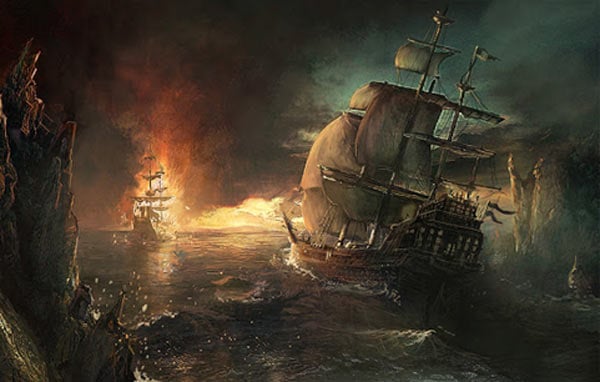Thames Shipwreck identified as Cherabin, English pirate ship that pillaged for the Queen
After a decade of research on a 16 th century shipwreck recovered from the Thames River in England, researchers have finally been able to identify it as the Cherabin, England’s only surviving state supported pirate ship, according to a news release in the Daily Mail. While official accounts described the Cherabin as a trading ship, historical records reveal that the Cherabin has a darker tale to tell. The ship’s crew were privateers, state-sanctioned pirates whose raids on Spanish ships to assert England’s dominance were signed and sealed by the High Court of Admiralty and approved by Queen Elizabeth I.
The Port of London Authority (PLA) were undertaking clearance work in the Princes Channel in 2003, to facilitate the passage of modern shipping in the Thames, when they came upon the remains of an old ship, including substantial fragments of the hull, anchors, canons, and cargo.
Studies on the wreck show that the ship was of about 160 tons, 24.5m in length, and 7.4m in width. The hull was strongly framed and furnished with integral gunports, revealing that it was a typical robust, armed merchantman of the Elizabethan era, capable of voyaging very long distances.

Part of the hull of the ship found in the Thames in 2003 by the Port of London Authority. Image source: Gresham Ship Photomosaic Stoney Cove 2013
Underwater archaeologists retrieved an exceptional array of artifacts from the wreck including a tin ingot stamped with the royal mark, a knife with a double fleur-de-lis stamped on the blade, iron guns, lead ingots, a round-toed leather shoe and a silk doublet of late 16th-century type. One of the iron guns had the ‘TG’ insignia on the barrel as well as the moulded emblem of a grasshopper. This is the mark of Sir Thomas Gresham (1519-1579), the famous London financier, merchant and gunfounder. The ship subsequently became known as the ‘Gresham ship’.

Divers examining the Gresham ship. Image source: Gresham Ship Photomosaic Stoney Cove 2013
Privateering, legalised pirating on the high seas
Since gunports had been deliberately built into the primary design of the hull, it is clear that skirmishes on the high seas were anticipated and expected. Piracy and privateering was rampant and it appears this ship had a very direct role to play in it.
During the 16th century, a form of legalised piracy was permitted by the English Crown, in which pirates were given ‘letters of marque and reprisal’, a government license authorizing privateers to attack and capture enemy vessels and bring them before admiralty courts for condemnation and sale. This effectively authorised their raids on Spanish ships. The privateers were different from pirates in only one way: they were supported by the state.
During the 19-year Anglo-Spanish War, which was never formally declared despite the famed battle with the Spanish Armada of 1588, privateers proved a crucial weapon to undermine the enemy. The ships would sail near the Caribbean and Spanish coasts, trying to intercept the treasures of their rivals to assert England's dominance.
Identifying the Gresham Ship
After its discovery in 2003 by the PLA, the Gresham Ship was raised from the murky waters where it had spent the last four centuries, and samples were sent to Denmark and the University College London for study. Now, after a decade of research, scientists have announced the likelihood that the Gresham Ship is in fact the Cherabin, one of 70 privateers, which stole £97,000 under the reign of Elizabeth I.

The Gresham Ship was raised from the Thames and has undergone more than a decade of research. Credit: Gresham Ship Project
Dr Gustav Milne, an honorary senior lecturer at University College London's Institute of Archaeology who led the project, said the similarities were striking. Both ships were a similar size and age, both sank fully-laden as they left London, both were armed merchantmen, and both had evidence which pointed to them losing their sails and rudders. While the evidence for the association is very strong, the researchers were also keen to point out that they can never by one hundred per cent sure they have the right ship.
The ship's oak timbers are now part of an ‘underwater museum’ in Stoney Cove, Leicestershire, which is explored by the site's 30,000 trainee divers each year.
For more information visit Gresham College's website.
Featured image: Piracy and privateering was rampant on the high seas throughout the 16 th and 17 th centuries. Image source.


















Comments
there are probably thousands more pirate ships on the ocean floor and else where.
Peace and Love,
Ricky.